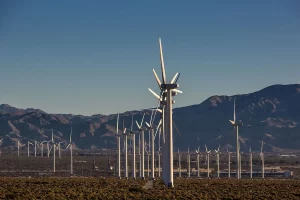
Geothermal Energy
Geothermal energy is heat extracted from the Earth’s interior. This heat reaches the earth’s surface in the form of steam and hot water and can be used to generate electricity and heat.
Existing technologies make it possible to generate electricity from geothermal sources directly from high-temperature steam, from steam-water mixtures using flash technology or from geothermal water using binary technology. For example, to obtain geothermal energy, a well is drilled, usually more than 1 km deep. The borehole extracts steam and hot water from underground. The hot water is continuously circulated down the well and the hot steam is used to produce thermal energy.
The production of geothermal energy for industrial purposes started in the 20th century. One of the first power plants was the Italian geothermal power plant with a total capacity of about 250 kW. Over time, the development of geothermal energy in the world has intensified. According to the International Geothermal Association (IGA), geothermal resources are exploited in 83 countries worldwide.
Principle of operation and dissemination of the technology
Depending on the type of heat transfer medium, geothermal power plants are divided into:
- hydrothermal;
- petrothermal.
Hydrothermal power plants use a mixture of water and steam heated in the earth’s interior and supplied naturally or by pumps. The hot thermal fluid is sent to the impeller of a turbine connected to a generator.
The exhaust steam is condensed and pumped back into the ground (geocirculation principle). The temperature of the working mixture at the turbine inlet reaches up to +300°C. These plants are located in seismically active regions with fault zones in the earth’s crust.
If the flow temperature of the steam-water mixture is +80 … +120°C, binary type plants are used to generate electricity. The heat transfer medium brings the gas mixture, which acts on the turbine and circulates in a closed circuit, to its boiling point. The partially cooled mixture of steam and water is used to run the heating systems and then sent to a well to be reheated in the Earth’s interior. Sub-thermal water sources (+40…+70°C) are used for the operation of domestic and industrial heating systems with heat pumps.
Petrothermal energy uses the heat of dry rock. The temperature inside the Earth rises by an average of 2.5°C every 100 metres and reaches +125°C when a borehole is drilled 5 km away. Increasing the parameter to 10 km makes it possible to reach layers heated to +250°C. The power plant requires a pair of wells to supply water and to take the resulting steam to the turbines. The proliferation of petrothermal power is limited by the high costs of drilling and maintaining the boreholes and equipment.
Advantages and disadvantages of geothermal power
Advantages of geothermal energy:
- A large reservoir of thermal energy in the earth’s interior;
- Independence of operation of the plant from external weather factors or the season;
- High efficiency of energy complex, up to 80%;
- Reduction of carbon dioxide emissions;
- Versatility of plants (in addition to electric power generation, the complex is used for heating)
- The possibility of parallel extraction of rare-earth elements from salts dissolved in the coolant.
Disadvantages of the technologies:
- The need to drill deep wells to supply liquid and steam at a temperature of at least +150°C;
- Limited areas with natural sources of hot water located openly or at shallow depth from ground surface;
- The need to dispose of waste liquid with increased salinity (condensate cannot be discharged into water bodies);
- Corrosion of metal steam pipes and turbines due to dissolved salts in the coolant;
- Potential for earthquakes when drilling deep wells or operating geothermal power plants in seismically unstable regions.
You may also like:


